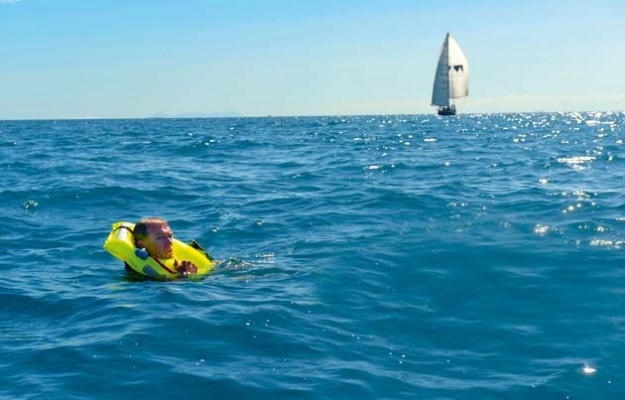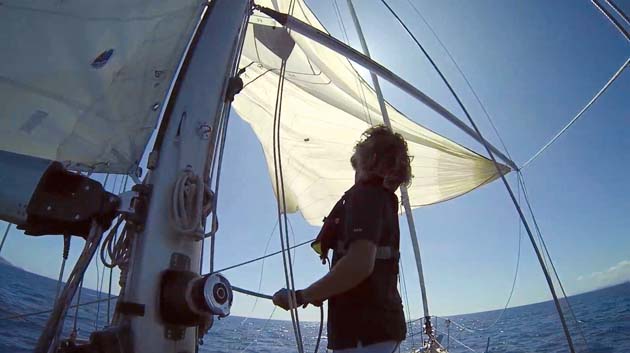It may be rare, but the consequences of losing a man overboard when sailing rapidly away under spinnaker are so serious that Dan Bower dedicates Part 7 to his advice
 Man overboard at sea is thankfully a very rare occurrence. But with any risk assessment, you have to consider the likelihood with the consequence and an MOB on an ocean crossing is very serious indeed. In usual tradewind conditions, wind and sea state make the chances of survival low.
Man overboard at sea is thankfully a very rare occurrence. But with any risk assessment, you have to consider the likelihood with the consequence and an MOB on an ocean crossing is very serious indeed. In usual tradewind conditions, wind and sea state make the chances of survival low.
On Skyelark we impress on our crew that falling overboard unclipped on a tradewind passage is definitely considered life-threatening and knowing what to do in various conditions in a timely manner is critical to survival – also that being clipped on is the surest means to a quick recovery.
Most people’s experience of MOB procedure has been practised in flat water under reduced sail in the shelter of coastal waters, which is a far cry from the reality of an ocean swell, running with poled-out sails or the spinnaker up, where the main problems are keeping sight of the casualty and stopping the boat. With a short-handed crew, the challenge is that much harder.
The first thing to do is stop the boat as quickly as possible to stay close to the casualty. Under normal circumstances it should be a crash tack (heave to). Under poled-out sails you have to accept that some damage may occur to the pole fittings or track, but so long as the boat is stopped when you’re still in sight of the MOB, the chances of finding and recovering them are greatly improved. It is easy and quick to drop or furl a backed headsail and in the hove-to position you can keep the casualty in sight while preparing for the recovery.
Act quickly
The more worrying scenario is what to do with the spinnaker up, since you are heading at speed away from the casualty and, unless you have a practised racing crew, by the time you have lowered the sail and turned around you will be some distance from the MOB.
During an ocean passage on an average cruising boat, an MOB is likely to leave a single person on deck with the remaining crew below. So any action must be performed quickly and it must be a set procedure that has been briefed beforehand, so there is no doubt or hesitation as to what to do. It’s therefore important to just have one protocol – play safe and ditch the spinnaker.
With the spinnaker up a crash tack is not an option as it is likely to cause further problems, perhaps a broach, or the kite caught in the rig and possibility of lines trailing in the water. The only safe, reliable option is to free the spinnaker completely, and recover the MOB under power.
Although it is important to stop the boat quickly, the manoeuvre should not be rushed – control lines need to be flaked and ready, without any stopper knots and released in the correct order, otherwise the spinnaker or lines under the boat and in the prop will minimise any chance of recovering the casualty at all.
Procedure for ditching the spinnaker
- Release the sheet and lazy guy. This will depower the sail and allow it to fly like a flag from the masthead and the pole end.
- Release the guy and lazy sheet. This causes the sail to fly from the masthead.
- Check for lines under the boat.
- Start the engine and begin turning the yacht towards the wind – this reduces the distance to the MOB and lessens the risk of running over the sail.
- Release the halyard. The sail and lines will now fly away and should land clear away from the boat some distance downwind before it hits the sea.
- Remove the preventer (if rigged), centre the main, secure the pole and do a standard mainsail up, MOB recovery.
Ditching the spinnaker is a drastic and expensive exercise, but when put in context of saving a life, there is no other option. The situation can be greatly improved by all crewmembers clipping on whenever recovering an MOB could be difficult and it’s worth having a clip-on rule whenever the spinnaker is up. This can seem a bit over the top when usually the boat is very stable downwind, but it is worthwhile practice, particularly if you are short-handed.
Personal trackers such as Raymarine’s Life Tag or AIS systems are another consideration and greatly improve the chances of getting to the MOB quickly. PLBs and EPIRBs will send a distress signal to the coastguard, but not to the yacht, which is realistically your best hope of rescue.
Once the boat is stopped, you have some time to get everything prepared to recover the MOB. If you are short-handed and planning to drop the mainsail or need to make adjustments that mean taking your eyes off the casualty, consider passing close by and deploying a Dan Buoy. If they are not wearing a lifejacket, give them some flotation.
You can’t risk taking your eyes off them to concentrate on other tasks as a head alone in a big sea is easily lost. It is best to make a pass, mark the position and then stand just off while you make the necessary preparations – you want everything ready to pick them up first time.
If you are fully crewed we would favour a mainsail-up approach, but this means having crew available to man the mainsheet and prevent the boat sailing away once you leave the helm to assist with the recovery. If you are sailing short-handed it may be best to drop the main, which it may be easy to do.
The approach should be upwind and into the swell, with a view to picking up the casualty at the shrouds. You should avoid getting them to close to a pounding bow or stern and we favour picking them up on the leeward side of the boat.
It is quite possible that conditions might be such that you cannot get close enough to pick them up. In this case, assuming they are fit and able, one option is to launch the liferaft upwind of the MOB, tethered to the boat, and drift it towards them – once they are in, the liferaft can be retrieved or you have a bigger, safer target to come alongside.
Do’s and don’ts
√ Do brief the crew on what to do, from stopping the boat to getting the MOB on board.
√ Do Do always have lines and halyards flaked and ready to run.
√ Do Do have a sharp knife handy and be sure everyone knows where it is.
x Don’t have stopper knots in control lines or halyards.
x Don’t start the engine until you are sure no lines are going to foul the prop when you do so.
Dan and Em Bower
Dan and Em Bower, both in their thirties, are lifelong sailors. Six years ago they bought Skyelark of London, a Skye 51 by American designer Rob Ladd, built in Taiwan in 1986, and have been sailing and chartering her ever since, making some 12 transatlantic crossings and covering around 60,000 miles.
Part 8: Man overboard recovery
Now you have to get your casualty back aboard, not easy in an ocean swell. Dan Bower gives some tips
See videos for all the parts here
12-part series in association with Pantaenius








